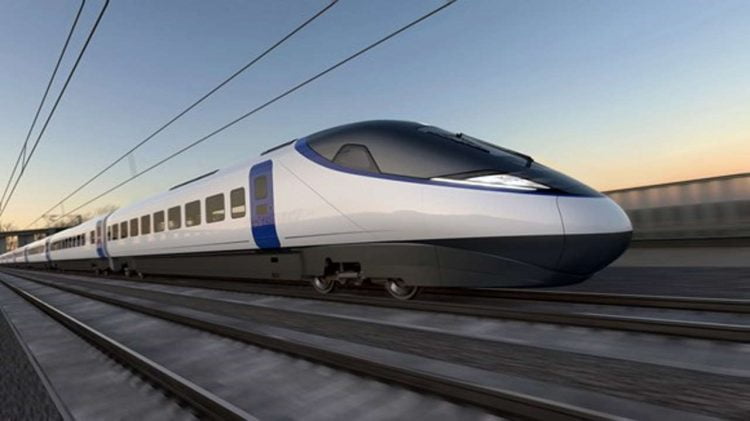HS2 has finished building a bridge at Streethay near Lichfield in Staffordshire.
The bridge was built by HS2's West Midlands civils contractor, Balfour Beatty VINCI, and designed by Mott MacDonald as part of a Design Joint Venture with SYSTRA (MMSDJV). Teams from eighteen specialist supply chain companies were also involved.
The work involved excavating fourteen thousand tonnes of earth, building a one-hundred-and-forty-metre retaining wall and moving a 2,600-tonne bridge deck one hundred and thirty metres into place under the freight railway in South Staffordshire.
To facilitate the work, a blockade was put in place for ten weeks.

The bridge deck was cast on land adjacent to the railway, and at the end of last month was moved into position using self-propelled modular transporters with 344 wheels. Each side of the bridge was then backfilled and the rail tracks reinstated. The railway line was successfully handed back to Network Rail on Wednesday 16 August and has now reopened.
The Streethay overbridge is twenty-five metres long and eighteen metres wide and sits within HS2's Streethay cutting. It will enable HS2 trains to travel under the existing railway between Birmingham and Crewe.
Mott MacDonald design engineers reduce the total length of wall structures for the railway at Streethay from 1,600m to 420m, so eighty per cent less concrete was needed, saving around 420,000 tonnes of carbon.
Up to one hundred and fifty workers at a time were engaged on the construction operation, with work including design, surveys, piling works, bridge build, concrete pouring, crane operations, reinforcements, modular transportation, track and systems removal and reinstatement.
The work was delivered in parallel to the construction of the nearby Fulfen Wood bridge, which involved moving a giant 6,200 tonne single span structure under the West Coast Main Line – the UK's heaviest drive to install an intersection bridge.
Prior to the railway blockade, engineers installed retaining walls on either side of the railway, which enabled the areas to be excavated.
Once the railway was closed to freight trains, engineering workers removed the track and embankment. Bachy Soletanche Balfour Beatty Ground Engineering joint venture then installed an extra seventy-six secant piles 1.3 metres in diameter and 30 metres deep, linking to the piles they had installed before the blockade started. This created two retaining walls which act as the walls for the bridge.
Next, the retaining walls had a concrete capping beam installed over them, and then the bridge was moved into place. Concrete was poured to attach the deck and the capping beam, and 2,500 tonnes of structural backfill was used to backfill the embankment on either side of the bridge. Once this was completed, the railway line was reinstated.
The bridge stands on top of the larger, 420-metre-long retaining wall structure, which will have another two bridges crossing it – the south bound A38 slip road bridge, and the Rykneld Bridge, which carries the A38 northbound slip road and the A38 north- and southbound carriageway.
The eighteen companies involved were: J. Murphy & Sons, constructing the bridge deck and the concrete elements; Bachy Soletanche Balfour Beatty Ground Engineering JV (SB3), undertaking piling works; Explore precast, making bridge parapets; Podtrak and RSS Infrastructure, delivering rail systems work; Balfour Beatty VINCI, carrying out earthworks; Pile Breaking Solutions, delivering pile break-down; TPA, supplying trackway; Mammoet UK jacking the structure and modular transportation; Aecom track monitoring survey works; King Lifting, supported by BBV lifting teams, supplying cranes; CEMEX, providing concrete; ROM, providing special reinforcement; RMD, carrying out temporary works; Design JV (Mott Macdonald and Systra) carrying out permanent works design; and Taylor Woodrow carrying out temporary works design.
The next stage of HS2 construction work in this area will include building two HS2 overbridges to run under the A38.
Caroline Warrington, Senior Project Manager at HS2 Ltd said: “This is a fantastic example of a project within a project at HS2, pulling together teams from 18 specialist supply chain companies from the West Midlands as well as other regions, to deliver a complex construction operation. These are some of the many companies that are helping to build Britain's new zero carbon railway, supporting thousands of jobs right across the country.
“Unlike the Fulfen Wood bridge structure, which was constructed entirely off site, the Streethay bridge walls under the railway embankment had to be constructed during the blockade. This required a 72 day blockade, making it more of a marathon than a sprint!”
David Millar, Rail Interface Manager at Balfour Beatty VINCI said: “The successful delivery of this complex and challenging piece of engineering near Lichfield is another proud moment for Balfour Beatty VINCI on the HS2 project.
“It's only been possible thanks to the skill, dedication and support shown by the project team over the past few years, including our supply chain. Together, we've had to work around existing transport infrastructure, including the South Staffordshire freight railway and the A38, making this achievement even more rewarding.”
Mark Jordan, Mainline Design Director at Mott MacDonald Systra Design Joint Venture: “We're immensely proud of the collaborative effort to get the design for this critical structure and operation ready for HS2. It's no small task to coordinate milestones like the Streethay bridge, with expertise from our geotechnical and structural engineering teams delivering design to meet the interfacing requirements of both HS2 and Network Rail, and innovation to enable off-site construction and transportation of the 2,600 tonne structure by Self Propelled Modular Transport.”